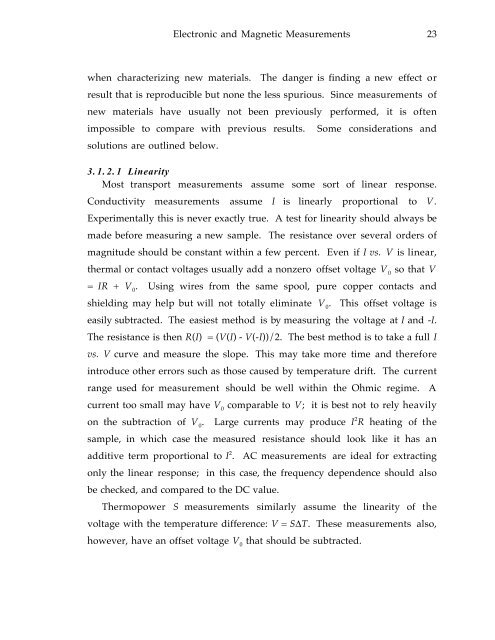MAGNETISM ELECTRON TRANSPORT MAGNETORESISTIVE LANTHANUM CALCIUM MANGANITE
MAGNETISM ELECTRON TRANSPORT MAGNETORESISTIVE LANTHANUM CALCIUM MANGANITE
MAGNETISM ELECTRON TRANSPORT MAGNETORESISTIVE LANTHANUM CALCIUM MANGANITE
Create successful ePaper yourself
Turn your PDF publications into a flip-book with our unique Google optimized e-Paper software.
Electronic and Magnetic Measurements 23<br />
when characterizing new materials. The danger is finding a new effect or<br />
result that is reproducible but none the less spurious. Since measurements of<br />
new materials have usually not been previously performed, it is often<br />
impossible to compare with previous results. Some considerations and<br />
solutions are outlined below.<br />
3.1.2.1 Linearity<br />
Most transport measurements assume some sort of linear response.<br />
Conductivity measurements assume I is linearly proportional to V.<br />
Experimentally this is never exactly true. A test for linearity should always be<br />
made before measuring a new sample. The resistance over several orders of<br />
magnitude should be constant within a few percent. Even if I vs. V is linear,<br />
thermal or contact voltages usually add a nonzero offset voltage V 0 so that V<br />
= IR + V 0 . Using wires from the same spool, pure copper contacts and<br />
shielding may help but will not totally eliminate V 0 . This offset voltage is<br />
easily subtracted. The easiest method is by measuring the voltage at I and -I.<br />
The resistance is then R(I) = (V(I) - V(-I))/2. The best method is to take a full I<br />
vs. V curve and measure the slope. This may take more time and therefore<br />
introduce other errors such as those caused by temperature drift. The current<br />
range used for measurement should be well within the Ohmic regime. A<br />
current too small may have V 0 comparable to V; it is best not to rely heavily<br />
on the subtraction of V 0 . Large currents may produce I 2 R heating of the<br />
sample, in which case the measured resistance should look like it has an<br />
additive term proportional to I 2 . AC measurements are ideal for extracting<br />
only the linear response; in this case, the frequency dependence should also<br />
be checked, and compared to the DC value.<br />
Thermopower S measurements similarly assume the linearity of the<br />
voltage with the temperature difference: V = SΔT. These measurements also,<br />
however, have an offset voltage V 0 that should be subtracted.
















